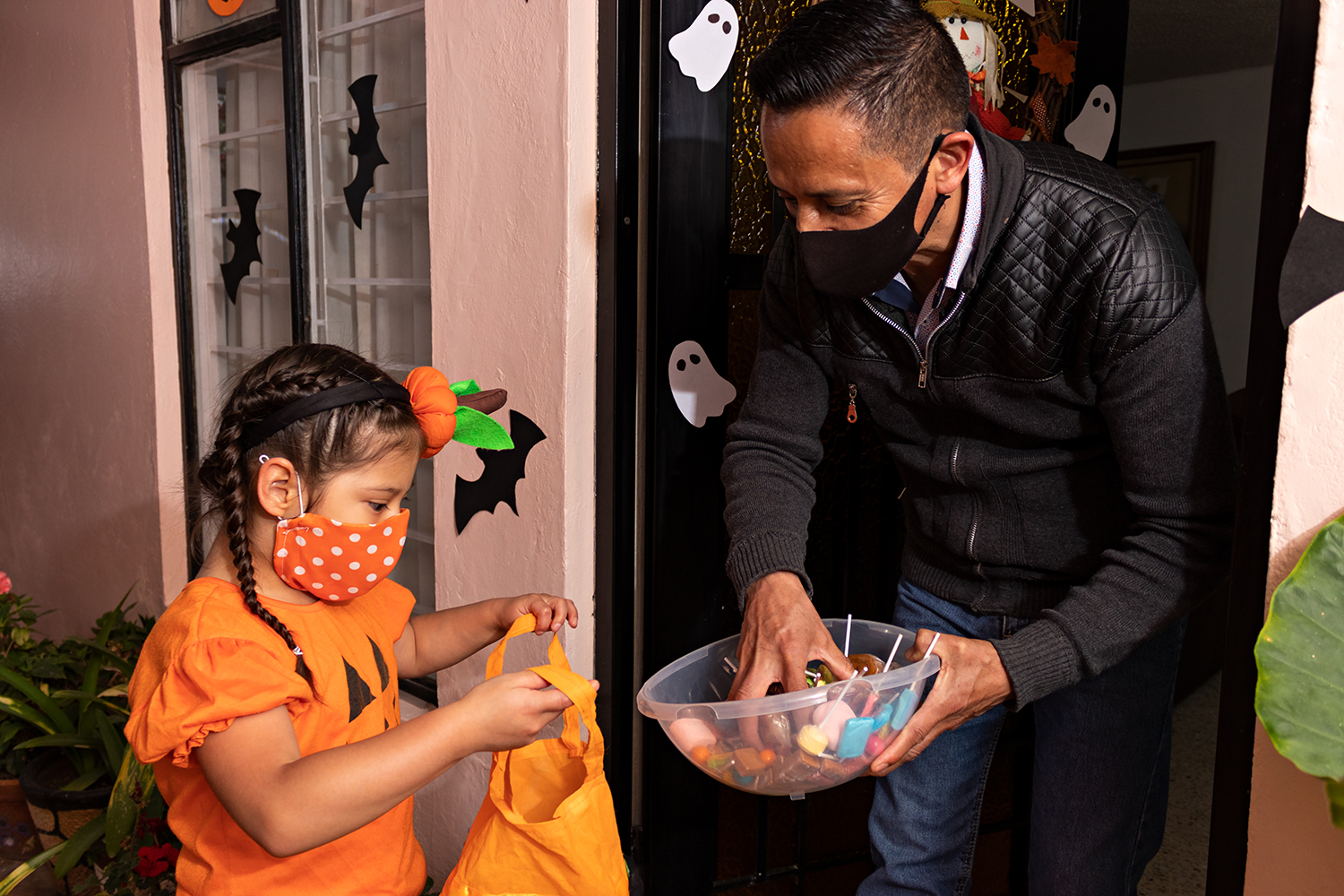Most trick-or-treaters are children who are not yet eligible to be vaccinated so it’s extra important for parents to encourage them to take these safety precautions to stay safe and healthy:
- Plan for outdoor events and dress for the weather
- Maintain physical distance (3-6 feet) from others outside one’s household when possible
- Everyone aged 2 years and older in Illinois, regardless of vaccination status, must wear a mask when in public indoor settings
- The best precautionary measure for the holiday season is for those who are eligible (12 years old and up) to get vaccinated
- Everyone 6 months and older are recommended to get the seasonal flu vaccine.
Please see the guidance below to keep you and your children safe and COVID-free.
Masks
An Executive Order from the Governor requires all people aged 2 years and older who can medically tolerate a mask to wear a mask over their nose and mouth when in an indoor public place.
Encourage kids and others dressing up to incorporate a mask as part of their costume. A costume mask is NOT a substitute for a well-fitting face mask like a KN95 to prevent the spread of COVID-19.
*Do not wear a costume mask over a mask to prevent the spread of COVID-19 because it could make breathing more difficult.
Neighborhood Trick-or-Treating
- Outdoor areas are safer for trick-or-treating than enclosed indoor areas, like apartment buildings, that put you at a greater risk of transmission.
- Trick-or-treating in small groups, as opposed to large groups, is recommended. Keep visits to front doors brief.
If trick-or-treating outdoors is not possible, here are things you can do to make indoor trick-or-treating safer:
- Hosts should open doors and windows as much as possible to increase ventilation
- Wear masks indoors and wear them properly so that noses and mouths are completely covered
- •Hand washing is important, especially for those handing out and receiving treats. Wash hands with soap and water for at least 20 seconds or use an alcohol-based hand sanitizer that contains at least 60% alcohol both before handling or eating treats.
Alternative Trick-or-Treating
Alternative activities may involve trick-or-treating in a parking lot or other outdoor setting. Individually wrapped or prepackaged candy or treats can be set out ahead of time for trick-or-treaters. Kids can also have an outside parade in costume with a parent/guardian.
Haunted Houses, Woods, and Walks
Consider open-air haunted houses, haunted woods, or haunted walks with family and friends, which reduces the risk of transmission than indoor events.
Pumpkin Patches, Orchard Visits, and Fall Festivals
These outdoor events can be good alternatives to traditional trick-or-treating. Stay away from crowded spaces when possible and limit close contact with others in smaller spaces. Wear your mask in smaller spaces.
Social Gatherings and Halloween Parties at Private Homes Indoors
- Large gatherings with more people are higher risk than smaller gatherings.
- Indoor gatherings should allow for plenty of physical distancing.
- Non-crowded outdoor gatherings are safest.
- Open windows for ventilation as weather permits.
- When hosting family and friends who aren’t fully vaccinated, including children, guests should wear a mask to help minimize transmission.
Día de los Muertos
It is possible to make many of the traditional activities associated with Día de los Muertos less transmissible.
- Events and activities to honor deceased loved ones are safest held outdoors.
- Smaller indoor gatherings with physical distancing will have less risk of COVID-19 transmission.
- Exchanging traditional family recipes with family or neighbors to make at a later date can also be a safe way to celebrate and remember deceased loved ones.
If You Develop Symptoms or Have Known Close Contact
If you think you might have COVID-19 or may have been exposed to someone with COVID-19, you should NOT participate in in-person Halloween festivities and should not give out candy to trick-or-treaters. Get tested as soon as possible.
If you develop symptoms consistent with COVID-19 or if you test positive for COVID-19, immediately isolate and contact others who you were in close contact with. Contact your health care provider and follow the CDC-recommended steps for what to do if you become sick .
If you are fully vaccinated and were in close contact with someone who tested positive for COVID-19, monitor for symptoms of COVID-19 for 14 days. If you have no symptoms, get tested for COVID-19 3-5 days following the exposure and wear a mask in public indoor settings for 14 days or until you receive a negative test result. If you have symptoms or test positive for COVID-19, isolate yourself from others and contact a health care provider for evaluation.
If you are not fully vaccinated and were in close contact with someone who tested positive for COVID-19:
- Stay home for 14 days from the last time you had close contact with that person.
- Monitor for symptoms of COVID-19.
- Get tested for COVID-19 5-7 days after that exposure.
Stay safe and enjoy this Halloween!


